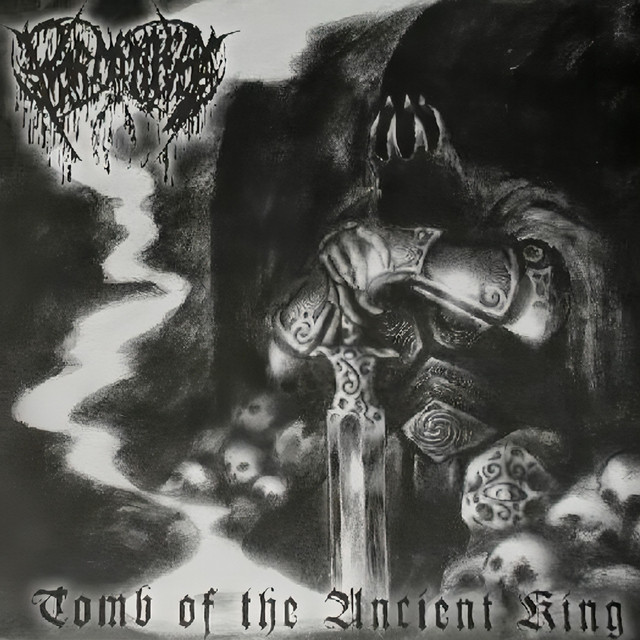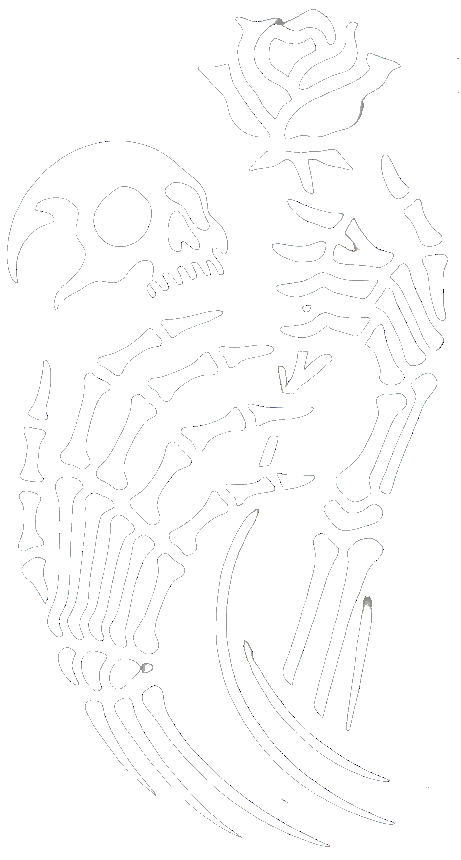The short-lived project Wormphlegm has always been more than just the side-project of the Finnish funeral doom institution Tyranny. It only released this one album, on the small label Painiac, as part of the special series “Suicidal Doom”, exclusively as an LP in a limited edition of 500 copies. And damn, today someone is asking over 500€ for the vinyl on Discogs, and someone will probably be willing to pay that.
But let’s for a moment leave aside the international second-hand record market, that Manchester-capitalist pile of nonsense that even global digitalization couldn’t liberalize, and focus on Wormphlegm. With “Tomb of the Ancient King”, the band delivered a work that rightfully belongs to the most influential releases in the recently covered torture doom genre. It is a dirty, obscure, and mystical gem of funeral doom, and perhaps the pivotal work of torture doom itself.
“Tomb of the Ancient King” was already an obscure object of unclear references back then. Lauri Lindqvist and Matti Mäkelä were very tight-lipped about information. There was nothing to know, nothing to see, just the product and a few hints that one has to make their own associative thoughts – if they wanted to know more. It’s a play-on-words that incorporates literary and mythological references to themes of illness, decay, and excrement in the band and album names, as well as the song titles.
Theater of Cruelties
It’s known today that the album was shaped by the magic of improvisation:
Every time the musicians played together, they used the ritualistic aspect of repetitive patterns but improvised upon this framework. No Wormphlegm session sounded like the previous one. It was a circling and enclosing of a sound without having a concrete goal in mind. The musicians weren’t searching for a particular sound but were shaping a musical process of the threatening freedom of the moment. It wasn’t the capriciousness of prog and jazz that supported the Finns, but rather noise, krautrock, and Antonin Artaud. Artaud and the interpreters of noise, like Wormphlegm, didn’t aim for reproducibility through notation, but placed confrontation and experience at the center of their pieces.
Artaud formulated the philosophy behind these ideas in his writing “Le Théâtre et son double”, with the idea of the “Theater of Cruelty”. The concept, developed in the 1930s, involved the desire to overload the audience’s senses with violent and confrontational actions and images, sharp and penetrating sounds, and harsh stage lights, in order to challenge the way they perceive the world. It aimed to repurpose image, expression, and voice, stripping the articulation of language, only to load it anew. Without a coherent text and without direct explanations, the audience is challenged to discover its own content. The confrontation with the unexplained, and perhaps the incomprehensible, becomes a confrontation with the self. References to mythology and associative word fragments, vague references – everything becomes a mirror of knowledge. And Wormphlegm played, intentionally or not, in this tradition.
A Tonal Anti-Paradise
“Tomb of the Ancient King” is an album full of references to archaic mythology, ancient times, Lovecraftian atmospheres, religious fragments, and human excretions. Far from a lamentation about the loss of one’s roots and old times, it suggests a dark mythos dealing with an intangible yet oppressive past.
The music itself becomes a powerful echo of a seemingly lost, perhaps never-existent, world of collective memory. A chilling, disturbing confrontation with an archetypal, anti-paradisiacal past, between delusion and rage, in wild, raw, and repetitive music. An ancient past whose atmosphere is closer to Lovecraft and Robert E. Howard’s Hyboria than to Tolkien, Arthur, or Odin.
Musical Brutality and Aesthetic Fury
The sound of “Tomb of the Ancient King”, upon its release, was one of the slowest and heaviest listening experiences in metal at the time. More pressing and torturous than the drone doom that fluctuates between irony and deconstruction, Wormphlegm negated the safety net of an intellectual framework in their music and surrendered to the hypnotic confrontation. The oppressive, sluggish guitar riffs do not really develop; they remain, vary, and decay. The cold, monotonous soundscapes of Faust and Kraftwerk foreshadowed this idea far more than Earth, Sunn O))) or The Melvins. Just like the repetitive and cold nature of krautrock, the repetitive and raw quality of Wormphlegm suggests the dissolution of identity. The focus on the monotonous and hypnotic stretches the perception of time and space, pushing any sense of metal or rock music into emptiness, without a climax or inner development.
Already in the opening track, this threatening monotony is evident in the slowly droning, endlessly repeating strikes on a piano key. Aggressively struck chords, distorted melodies, and the unpredictably abrupt rhythm changes remain throughout the entire album with no discernible goal – just a purist “musique brute”-expression of captivity in one’s own delusion. A delusion that is made tangible especially by the vocals, which shift between ghostly wailing, screaming, and growls. Meanwhile, the brutally raw drumming sounds like the stomping drums of a forgotten cult in worship of the Great Old Ones. The slowly advancing repetition manifests an almost demonic, unstoppable presence that only breathes rage and despair.
This slow, almost torturous buildup of tension and energy, which elevates the album to the manifesto of torture doom, combines expressive fury, rooted in the past, but unrelentingly breaking into the present. A fury that is not directed against the past, but that Lovecraftian force that drives it forth: an incomprehensible, raw, and instinctive disgust for existence itself. The hatred of a wild divine entity, whose presence seems lost, yet still influences existence. Hatred, rage, and despair that find no climax, no release, no catharsis.
Myth and Cosmic Madness
The loss and destruction of the myth are unmistakably present, but the form of this loss is fluid. Instead of a tangible past, the listener is confronted with vague facets, whose remains, like obscure relics of another reality, reach into the present. A world of the incomprehensible and the dangerous. A kaleidoscopic collection of mythological fragments that don’t simply document, but are literary – like excerpts from an ancient, incomprehensible mythos glimmering in the dark. Symbols of cultures and gods, and the manifestation of sinister objects that bring the incomprehensible past into our world.
This cosmic ignorance is something the musicians brought from their work with Tyranny, influenced by the works of H.P. Lovecraft. His tales of people driven mad after encountering the unfathomable truths of the universe resonate in “Tomb of the Ancient King”. The mythos of a pre-Christian era, whose unresolved secrets bring disaster into the present – not clearly articulated, but vaguely evoked. A violent encounter with a long-forgotten, but still existent, cosmic presence that overwhelms the listener, pushed between the predetermined text fragments of the opening track “Epejumalat monet tesse muinen palveltin caucan ja lesse” and the terms with which the tracks and album were named.
The mystical power of this past, this living, unpredictable relic that can neither be fully integrated into the present nor completely removed from it. The “ancient king” is the ghost of this culture, which still influences the present. He is reminiscent of Chambers’ “King in Yellow”, that entity which in the “Cthulhu Mythos” symbolizes the uncanny, the incomprehensible, the knowledge that drives one to madness. Here we have the approach of a cosmic truth that, once confronted, inevitably influences those who engage with it and traps them in that state of delusion and destruction – leading the listener on a journey into dark, unfathomable depths. Not in a simple narrative, not in a performance, but in the immediate experience of madness, hatred, despair, and rage, as envisioned by Artaud.
A Monument of Cosmic Wrath
In its dark, raw, and furious aesthetic, “Tomb of the Ancient King” does not simply manifest a mythos of an incomprehensible, supernatural past. It immerses the listener in a world where time and space no longer have clear categories, and madness retreats before the threatening presence. “Tomb of the Ancient King” is an archetypal apocalyptic experience of cosmic violence and rightly remains as a timeless classic of funeral doom and the cornerstone of torture doom.

